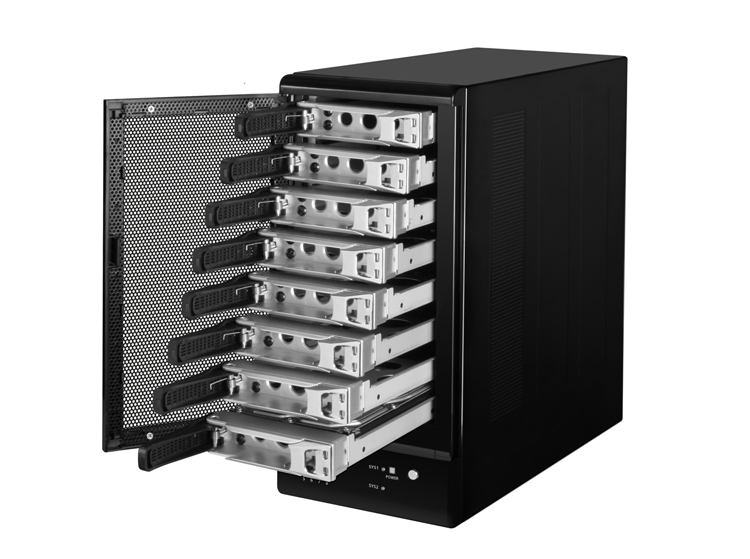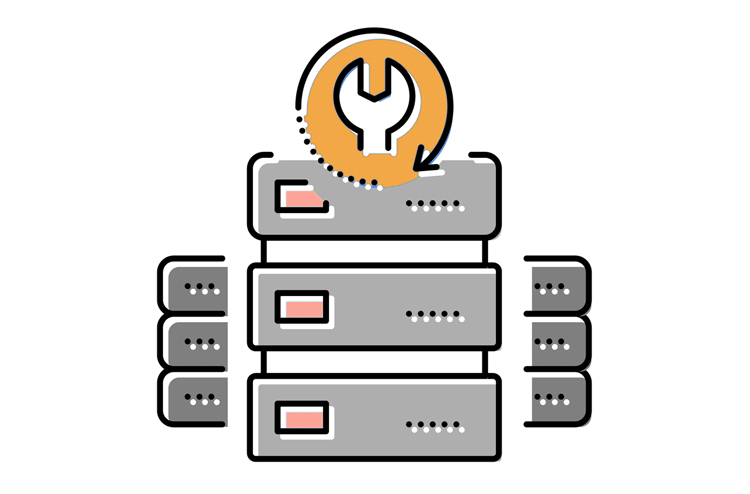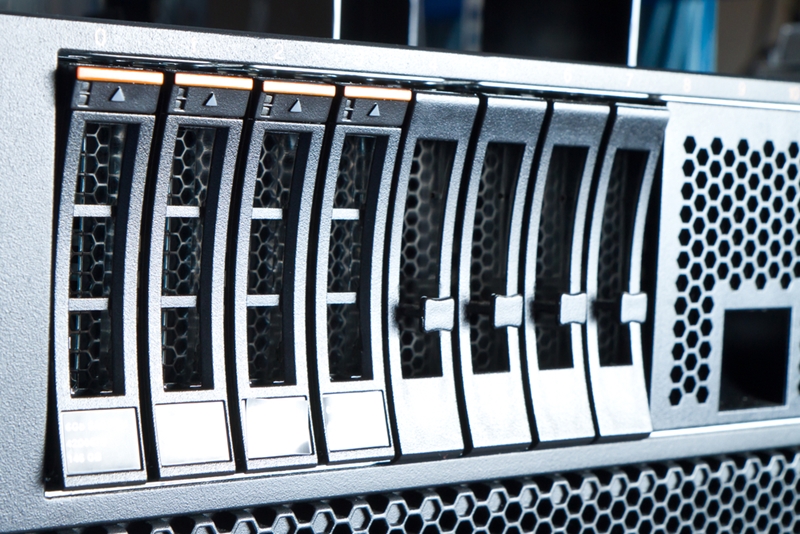What is RAID Storage?
RAID is one of the types of memory storage technologies that includes received much attention due to its innovation. RAID is short for Redundant Array of Inexpensive Disks, which explains the operation of RAID well. Briefly, if we want to explain the function of RAID, we must say that it stores data between several hard drives that are connected together in RAID so that you can distribute them.
RAID technology simultaneously stores data and information on several hard drives, which helps your data to be more secure.
Stay with us in this article if you want to know more about RAID storage technology.
What is RAID?
RAID is a method of storing the same data in different locations on multiple hard disks or SSD drives to protect data in the event of a failure. RAID can combine multiple hard drives to increase speed, performance, security, and storage. Several hard disks are connected form a unit. The implementation level of RAID implementation can be effective in increasing system efficiency.
Generally, servers and computers with high-performance use this technology. This technology stores information in parallel on several hard disks at the same time; This will ensure that if a problem occurs with one of the disks, data will still be available.
You can implement this RAID both in software and hardware form, the hardware model of which is both faster and more stable, but if you don’t have a lot of money to spend on RAID hardware, our recommendation is to use its software model. We still recommend using the software version if you use RAID on a backup system.
When you use software RAID technology, the operating system BIOS will implement it, and when you use hardware technology, this responsibility will be the responsibility of the Raid Controller, which naturally has more capabilities than the hardware controller. It has a software version, and the performance that can be expected from it is better than its software version.
Disks that are connected are just like an array, where each of these disks is a member of the variety, and the way these arrays are connected determines their level, which is known as RAID level. ; RAID levels are named with numbers, for example, RAID 0 and RAID 1.
But why are RAID architectures different?
- Development and increase of security
- Improving and increasing the efficiency of input and output data
- Increase capacity
Review of techniques and types of RAID storage
In this section, we want to review the techniques and types of RAID storage.
Striping
The first thing we want to introduce is the Striping technique; In this technique, information is divided into parts with certain sizes, and after that, the work of writing this information on hard disks starts in order, which causes the storage space to increase.
Mirroring
Mirroring is another RAID storage technique in which a copy of data is written simultaneously on several hard disks, protecting data and preventing data loss.
Parity technique
This storage technique is also similar to the Striping technique; in a way that divides the information into equal parts. The information stored in the parity allows the RAID system to identify and restore the hard drive data if there is a problem.
Other RAID techniques are a combination of these three. Of course, we will introduce you to each type of RAID.

Types of RAID technologies
In this, we intend to introduce you to various RAID technologies.
What is RAID 0 technology?
The first and simplest RAID type is RAID 0, which is usually installed on operating systems. If you have dynamically connected your system’s disk management and strip, then you have used RAID mode.
Stripped and Spanned are the types of RAID 0. Meanwhile, all the hard drives are connected consecutively without having a reserve or replacement hard drive.
In this model, the speed is very high and it can be roughly said that all hard drives can be used. To use this RAID model, it is necessary to have at least two Storage on the system or storage.
RAID 1
If we want to introduce one of the safest types of RAID, we must mention RAID 1. In this RAID model, the number of hard drives on the storage system must be even; Because in this RAID storage method, half of the hard drives are considered as online reserve hard drives for the other half.
In the RAID 1 method, when a file is written on the main hard drive, a copy is also written as a backup file on the reserve hard drive. Of course, since writing is done twice, the speed of RAID is halved, but this method also has an advantage: if one of the hard drives is destroyed for any reason, a hard drive can be used as a backup. That device exists and users can use the hard backup without any problems or outages in the system. In some centers where security is one of the important factors, this type of RAID is generally used.
RAID 2 technology
RAID 2 technology uses Hamming code to correct errors. In RAID 2, disks use striping, which uses EEC to ensure data security. Of course, it is better to mention that RAID 2 technology requires high costs and hard implementations, which is completely obsolete and is now included among non-standard RAIDs.
RAID 3
The third type of RAID technology we want to introduce is RAID 3 technology, which also uses data striping and has a dedicated hard disk to store parity data. In this type of hard drive, errors can be detected with the help of ECC.
RAID 4
RAID 4 and RAID 3 are very similar to each other, and perhaps the main difference between them is the difference in how data is shared. RAID 4 uses large stripes that allow you to read any record from any drive. This distribution can greatly increase performance, but the catch is that it requires at least three disks to fully implement and configure it.

RAID 5 technology
In this disk model, at least three disks are required. The method used in RAID 5 is similar to the storage of information in the mirroring method; in addition, a parity code is used that is distributed between the disks, which increases the performance and It can be recovered if a problem occurs. If we want to compare RAID 5 with RAID 1, we must say that it has a lower speed in writing information; The reason for this is that more time is needed to write parity information. Of course, we must point out that currently, one of the most widely used RAID models in all types of storage is RAID 5 mode, which is used in almost all storage and some office and home workstations to detect a large number of hard drives.
Of course, there is another type of disk called Hot spare, which is used as a backup for RAID array. These disks are physically installed in the array and remain inactive until the active disks fail.
RAID has a controller that automatically replaces failed drivers with spare disks and restarts processes for the array. A RAID 5 array with a hot spare disk is equal to the number of RAID 6 disks and has the advantage that it provides more flexibility during protection in case something goes wrong.
RAID 6 technology
This storage technology is also similar to its previous counterpart, RAID 5. To highlight the difference, we must say that in RAID 6, two offline reserved hard drives have been added. This makes the security factor higher than RAID 5. RAID 6 technology is one of the latest models, with higher security and speed than RAID 5.
RAID 10
Another type of RAID exists is RAID 10, a combination of RAID 0 and RAID 1 technology. For example, imagine that we have eight hard drives; in this case, half of the hard drives form RAID 1 together and provide higher security; The other half of the hard drives will be RAID 0 to increase the writing speed on these hard drives. It is easy to conclude that security and speed are at a higher level in this type of hard drive.
RAID 50 technology
In this technology, the combination of RAID 0 and RAID 5 is used. In RAID 5, we said that a limited number of hard drives could be RAID 5; in this RAID 50 technology, this problem has been solved to a large extent. In this storage model, all hard drives are divided into smaller parts, and each part is set as RAID 5.
RAID 5 packages are combined and configured as RAID 0 so that users can access their hard drives and volumes.
What is a RAID controller?
RAID controller can be both a hardware piece and a software mode; The task of the RAID controller is to ensure that a hard disk can perform its task properly.
RAID controller is a type of chip that is placed as an interface between the hard disk and the operating system so that it can improve the performance of the disk and manage the huge amount of data and when a failure occurs, it can protect them well.
If we want to talk about the benefits of RAID controllers, we should mention things like protecting the hard drive, increasing the hard drive’s life, and increasing and improving the hard drive’s performance.

What is the best type of RAID?
Depending on the applications that are running on the server, the level and type of RAID is selected. But based on the unique features of each RAID, it can be said that the fastest RAID is RAID 0 and the most secure RAID is RAID 1, and in the meantime, RAID 5 is both faster and more reliable.
What are the benefits of using RAID?
One of the benefits of RAID that you have noticed so far is that it increases the efficiency of information and data storage systems.
Restoring and recovering information and data is due to the failure of hard disks. In simpler terms, if we want to explain, we have to say that RAID technology helps so that if the hard drive encounters a problem, the system can maintain its efficiency and continue to do so; In short, it provides security and data protection.
Another advantage of RAID is that it places data on more than one hard disk, and the input and output operations overlap, which can help increase the efficiency and speed of reading and writing information.
In RAID technology, you can get a large number of cheap disks and save money.
What are the disadvantages of using RAID?
So far we have talked about the benefits and uses of RAID, but don’t forget that RAID is not perfect either, and in this section, we want to discuss its disadvantages to complete your information about RAID.
When one of the drives fails, there is a high probability that the other drives will also fail, which can increase the possibility of data loss (this happens due to the simultaneous installation of disks). .
RAIDs such as RAID 1 and RAID 5 can only tolerate the failure of one hard drive.
As long as you don’t try to change or replace the broken hard drive, the arrays and their data are vulnerable, and even after replacing the hard drive, the new hard drive will quickly fill up with data.
Conclusion
In this article, we talked about RAID technology and talked about its features and functions and its types. Do not forget that you should use RAID technology based on your needs and the advantages and disadvantages that we have introduced here.
All our servers are equipped with RAID technology to protect your data at the highest level. You can visit our virtual server purchase page if you want to buy a virtual server with RAID technology.
If you have any questions in this regard, you can ask us in the comments section so that we can answer them as soon as possible.

